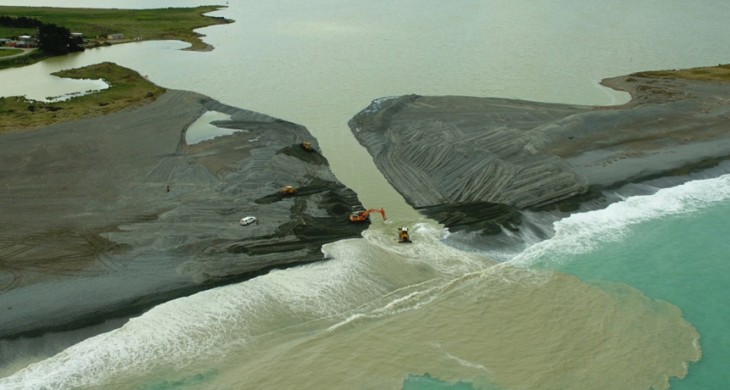27 November 2013
Kaitorete Spit is a long finger of land which extends along the east coast of Canterbury. It runs south-west from Te Pātaka a Rākaihautū/Banks Peninsula for 25 kilometres and separates the shallow waters of Te Waihora/Lake Ellesmere from the Pacific Ocean.
Kaitorete Spit is actually a low-lying barrier, with the tiny settlement of Birdlings Flat at its northern end and Taumutu and Ngāti Moki Marae at its southern end. The barrier is of considerable ecological significance, and it is home to the majority of surviving specimens of Shrubby tororaro/Muehlenbeckia astonii, a nationally endangered endemic plant.
Kaitorete Spit has considerable cultural value to Ngāi Tahu because of the ancestral associations with the area. Its ancestral name, Kā Poupou a Te Rakihouia denotes the function of the spit – which is similar to that of a tuna/eel weir, guiding tuna/eels into the mouth of the hinaki/tuna/eel trap. In this case, the tuna/eels are guided to the Taumutu area where the kōumu (tuna/eel channels) are constructed to catch migrating tuna/eels.
The Spit was also an important main trail between Waitaha o Waenga/mid-Canterbury and the south, as well as a place of seasonal food gathering, tool gathering and fishing camps. In archaeological terms it has one of the largest concentrations of Māori sites in the country.
Archeological finds at Kaitorete
It was here, in 2004, that one of the country’s most significant textile finds was unearthed – tiny fragments of a Korowai/Māori cloak carbon dated at around 1500AD, making it two centuries older than any cloak ever before found in Aotearoa New Zealand.
The oldest known cloak prior to the Kaitorete Spit find was a 17th century example unearthed in a Fiordland cave. Kaitorete Spit is around 6000 years old and is known to be one of the most ecologically and culturally important sites in Aotearoa New Zealand.
Archaeologists have also unearthed the charred remains of a small shelter, stones tools, a flounder midden, evidence of cooking ovens, pieces of Kōkōwai/red ochre traditionally used by Maori for painting and decorating, a second cloak fragment, pieces of woven sleeping mat, albatross bones, tools, pieces of roof thatch, part of a woven belt and a 600mm long segment of carved wood. All have been removed from the site and restored within the controlled environment of Canterbury Museum.
Kaitorete Spit contains a remarkable collection of plants, several rare species of insects, reptiles and birds and it is of significant cultural value to Ngāi Tahu for the fact that over 500 archaeological sites – many of them ancient ovens and tool-making areas – have been found there.

